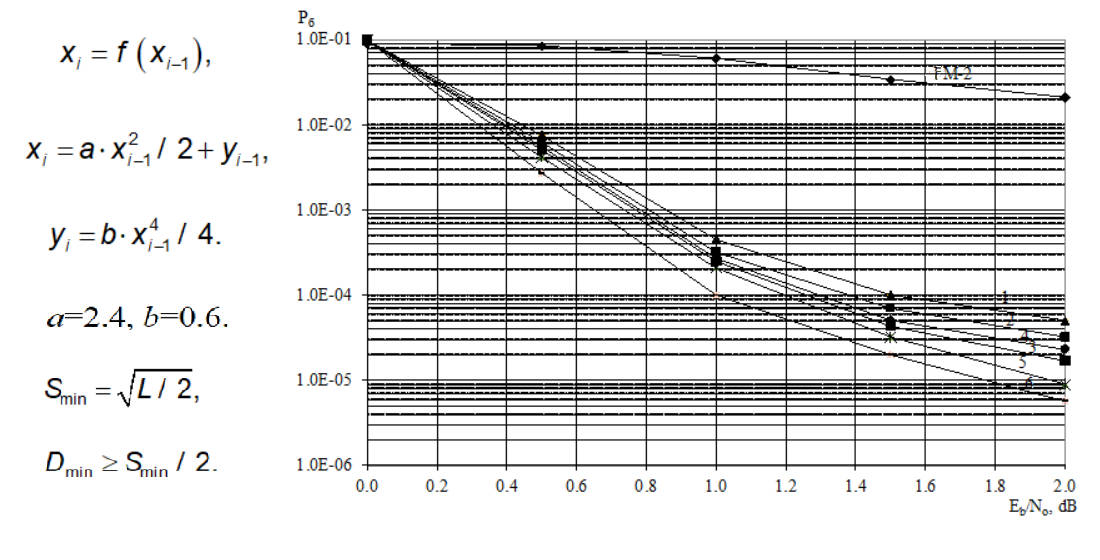Розробка модифікації хаотичного перемежувача у складі турбо-коду зі зміною на рівняння дуфінга та враховуванням дистанційного спектра коду
DOI:
https://doi.org/10.15587/1729-4061.2023.292850Ключові слова:
модифікований хаотичний перемежувач, рівняння Дуфінга, турбо-коди, дистанційний спектр, енергетична ефективністьАнотація
Розглянуто різні типи перемежувачів у складі турбо-кодів та їх параметри, що впливають на ефективність турбо-кодів. Зазначено, що тип перемежувача тобто закон формування елементів у перемежувачі дуже суттєво впливає на ефективність та завадостійкість турбо-кодів. Також на ефективність турбо-кодів впливає параметри мінімальної відстані, довжини перемежувача та дистанційний спектр коду.
Запропоновано модифікація хаотичного перемежувача у складі турбо-коду зі зміною рівняння на рівняння Дуфінга та враховування дистанційного спектра коду з умовою збільшення відстані між кодовими словами малою вагою. Представлено алгоритм модифікації хаотичного перемежувача за рівнянням Дуфінга та враховуванням дистанційного спектра коду у складі турбо-коду. Наведені характеристики модифікованого хаотичного перемежувача з рівнянням Дуфінга та враховуванням дистанційного спектра коду у складі турбо-кодів за різними параметрами турбо-кодів. Дана модифікація перемежувача у складі турбо-кодів підвищила мінімальну відстань між елементами за різними довжинами перемежувача та поліномами турбо-коду від 10 % до 33 %. Завдяки цьому відбулося підвищення енергетичної ефективності турбо-коду від 0,05, …, 0,25 дБ в порівнянні з хаотичним перемежувачем без модифікації у складі турбо-коду за тим самим значенням ймовірності помилки біта. Показано, що при збільшенні довжини модифікованого хаотичного перемежувача з рівнянням Дуфінга та враховуванням дистанційного спектра коду підвищення енергетичної ефективності турбо-коду в порівнянні з хаотичним перемежувачем без модифікації уповільнюється.
Сфера застосування модифікованого хаотичного перемежувача з рівнянням Дуфінга та враховуванням дистанційного спектра коду у складі турбо-коду є канали інфокомунікацій рухомого, провідного та супутникового зв’язку
Посилання
- Berrou, C., Glavieux, A., Thitimajshima, P. (1993). Near Shannon limit error-correcting coding and decoding: Turbo-codes. Proceedings of ICC ’93 - IEEE International Conference on Communications. doi: https://doi.org/10.1109/icc.1993.397441
- Mousavi, H., Amiri, I. S., Mostafavi, M. A., Choon, C. Y. (2019). LTE physical layer: Performance analysis and evaluation. Applied Computing and Informatics, 15 (1), 34–44. doi: https://doi.org/10.1016/j.aci.2017.09.008
- Alebady, W. Y., Hamad, A. A. (2023). Concatenated turbo polar-convolutional codes based on soft cancellation algorithm. Physical Communication, 58, 102010. doi: https://doi.org/10.1016/j.phycom.2023.102010
- Heegard, C., Wicker, S. B. (1999). Turbo Coding. Springer, 206. doi: https://doi.org/10.1007/978-1-4757-2999-3
- Andrews, K., Heegard, C., Kozen, D. (1997). A Theory of Interleavers. Available at: https://www.researchgate.net/publication/2264878_A_Theory_of_Interleavers
- Jinhong Yuan, Vucetic, B., Wen Feng. (1999). Combined turbo codes and interleaver design. IEEE Transactions on Communications, 47 (4), 484–487. doi: https://doi.org/10.1109/26.764913
- Dyrda, V., Dyrda, O. (2002). Shchodo pobudovy efektyvnykh heneratoriv psevdovypadkovykh chysel. Naukovi pratsi ONAZ im. O.S. Popova, 1, 71–75.
- Dolinar, S., Divsalar, D. (1995). Weight Distributions for Turbo Codes Using Random and Nonrandom Permutations. TDA Progress Report 42-12, 56–65. Available at: https://www.researchgate.net/publication/243773610_Weight_Distributions_for_Turbo_Codes_Using_Random_and_Nonrandom_Permutations
- Topalov, V., Zaharchenko, N., Kononovich, V. (2008). Modifikatsiya peremezhitelya s kodovym sootvetstviem. Eastern-European Journal of Enterprise Technologies, 35, 26–30.
- Sahnoune, A., Berkani, D. (2021). On the performance of chaotic interleaver for turbo codes. SN Applied Sciences, 3 (1). doi: https://doi.org/10.1007/s42452-021-04147-w
- Urrea, C., Kern, J., López-Escobar, R. (2022). Design of Chaotic Interleaver Based on Duffing Map for Turbo Code. Symmetry, 14 (12), 2529. doi: https://doi.org/10.3390/sym14122529
- Bazzi, L., Mahdian, M., Spielman, D. A. (2009). The Minimum Distance of Turbo-Like Codes. IEEE Transactions on Information Theory, 55 (1), 6–15. doi: https://doi.org/10.1109/tit.2008.2008114

##submission.downloads##
Опубліковано
Як цитувати
Номер
Розділ
Ліцензія
Авторське право (c) 2023 Vladislav Topalov, Iryna Tregubova, Mykola Severyn, Iryna Hurklis

Ця робота ліцензується відповідно до Creative Commons Attribution 4.0 International License.
Закріплення та умови передачі авторських прав (ідентифікація авторства) здійснюється у Ліцензійному договорі. Зокрема, автори залишають за собою право на авторство свого рукопису та передають журналу право першої публікації цієї роботи на умовах ліцензії Creative Commons CC BY. При цьому вони мають право укладати самостійно додаткові угоди, що стосуються неексклюзивного поширення роботи у тому вигляді, в якому вона була опублікована цим журналом, але за умови збереження посилання на першу публікацію статті в цьому журналі.
Ліцензійний договір – це документ, в якому автор гарантує, що володіє усіма авторськими правами на твір (рукопис, статтю, тощо).
Автори, підписуючи Ліцензійний договір з ПП «ТЕХНОЛОГІЧНИЙ ЦЕНТР», мають усі права на подальше використання свого твору за умови посилання на наше видання, в якому твір опублікований. Відповідно до умов Ліцензійного договору, Видавець ПП «ТЕХНОЛОГІЧНИЙ ЦЕНТР» не забирає ваші авторські права та отримує від авторів дозвіл на використання та розповсюдження публікації через світові наукові ресурси (власні електронні ресурси, наукометричні бази даних, репозитарії, бібліотеки тощо).
За відсутності підписаного Ліцензійного договору або за відсутністю вказаних в цьому договорі ідентифікаторів, що дають змогу ідентифікувати особу автора, редакція не має права працювати з рукописом.
Важливо пам’ятати, що існує і інший тип угоди між авторами та видавцями – коли авторські права передаються від авторів до видавця. В такому разі автори втрачають права власності на свій твір та не можуть його використовувати в будь-який спосіб.










